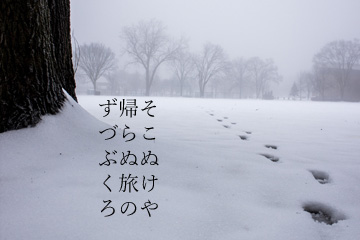
Home > Exhibits > Painting > Haiku
Home > Exhibits > Photography > Haiku
Haiku is one of the most famous forms of poetry in the Western hemisphere, right up there with the sonnet, but also one of the least understood. It is not enough to string along seventeen syllables in the pattern 5-7-5. Like the sonnet, haiku has its own rules and conventions which poets today ignore at their own peril.

Yet even those who know the various rules for the proper construction of a haiku may be unaware of the deep and time-honored connection this poetic form has with the visual arts. The Haiku show at 555 Gallery & Studios reminded us of that connection by recontextualizing art for haiku to present day Detroit. Each photo or painting had a haiku associated with it.
Andrew Evans chose five haiku by five different poets, but avoided Basho, regarded by some as being to haiku as Shakespeare to sonnet. His choice of Hokusai for one of his five photos was particularly appropriate, since Hokusai is today remembered mostly for his woodcuts. The most evocative of Andrew's photos is Voyage, with a haiku by Kyoshou:
そこぬけや
帰らぬ旅の
ずづぶくろ
sokonuke ya
kaeranu tabi no
zudubukuro
A journey of no return:
the wanderer's sack is
bottomless.
(Depending on your browser settings and available fonts, you might not be able to see the Japanese script text on this page. If that's the case, we hope that the romaji transliterations at least give some sense of the beauty and elegance of the originals).
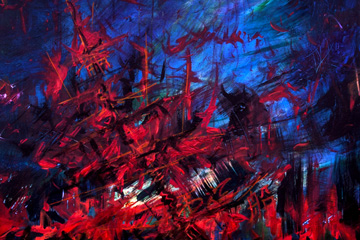
Don't feel bad for Basho, as he still had a strong presence in this show. Sanda Cook chose three haiku by Basho, including this one:
春風や
煙管くわえて
船頭殿
harukaze ya
kiseru kuwaete
Sendo-dono
In the spring breeze,
with pipe in mouth,
Mr. Boatman [waits for passengers].
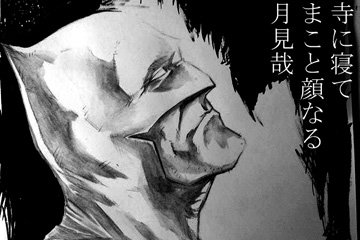
And even Batman finds a Basho haiku appropriate for his mood in a nocturnal drawing by John Marroquin, Jr.:
寺に寝て
まこと顔なる
月見哉
tera ni nete
makoto gao naru
tsukimi kana
At [the] temple, sleeping,
my true face
moon looking at
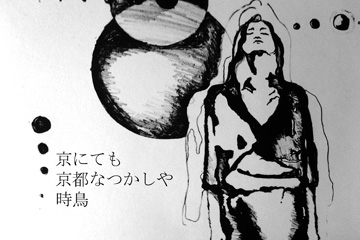
One of Basho's greatest hits concerns the cuckoo in Kyoto, a haiku which for Karana Hales evokes powerful memories:
京にても
京都なつかしや
時鳥
Kyou[toshi] nite mo
Kyou[toshi] natsukashi mo
hototogisu
Kyoto [I am in]
Kyoto nostalgia for [I feel]
[when I hear the] cuckoo.
According to the Detroit Historical Society, Kern's Clock was first installed in 1933 and removed in 1966 after the Ernst Kern department store went out of business a few years prior. It was in storage for a while, then put back out, and stored again when the Hudson building was demolished in 1998. In 2003, the clock was once more restored to its Woodward and Gratiot location, but the departure of Compuware will hopefully not cause the clock to go back into storage.
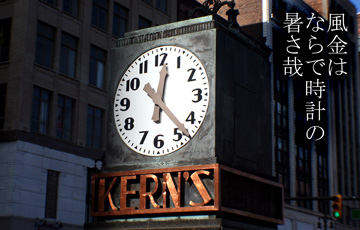
Thus Alonso del Arte decided to pair this Yayu haiku with a photo of Kern's Clock in downtown Detroit:
風金は
ならで時計の
暑さ哉
Fuurin [kaze kin] wa
narade tokei no
atsusa kana.
Wind-bells are silent;
the heat of the mechanical clock.
A black and white version of this photo was used for the cards announcing this show, which ran for two weeks in a torridly hot August 2014.
Originally, haiku were written as parts of longer linked poems called renga. For this show at 555, Julianne Lindsey (Exhibitions Director at the time) had the brilliant idea of having a board with thumbtacks and little pieces of paper in which visitors could write their own haiku. Most guests wrote haiku in English, but one guest, Elisabel Vega Argueta, wrote one in both English and Japanese:
しばふ上
はしゃぐクレイト
お客様も
shibafu jou
hashagu Kureito
okyakusama mo
Playing in the grass
Mischievous crates somersault
With the visitors
This haiku demonstrates an excellent awareness of renga tradition, as it was expected for one poet to write a verse in honor of the host. In this case, "mischievous crates" is a reference to a sculpture made up of milk crates that was in front of the gallery. This haiku is also quite unique in that it uses katakana in addition to hiragana and kanji.